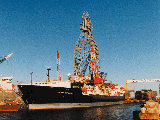What's happening in exploration
GOM deepwater exploration slated, from spy ship/drillshipTrue to its name the Glomar Explorer is scheduled to explore the Gulf of Mexico, as contracted in partnership by Chevron and Texaco, to water depths of 7,800 ft. Global Marine, Inc. has secured a 30-year lease with the U.S. Navy for use of the Explorer, originally designed at a cost of an estimated $500 million. Some history behind the Glomar Explorer. In 1974, the CIA ran an operation to recover a sunken Soviet submarine. The recovery effort centered on the Hughes Glomar Explorer, a 63,000-t deep-sea salvage vessel. The ship was built at the direction of Howard Hughes for use by his Global Marine Development, Inc., under the "cover story" that she was a deep-sea mining ship, intended to recover "manganese nodules" from the ocean floor.
The Soviet G-class ballistic missile submarine sank off Hawaii in April 1968, in 16,500 ft of water. After the recovery, the ship was transferred to the Navy and was not officially assigned a name, but was commonly referred to as the Glomar Explorer. She was transferred to the Maritime Administration in 1977, and laid up at Suisan Bay, Calif. The Navy attempted to sell the ship, but failed. From 1978 to 1980, she was leased to Global Marine for deep-ocean mining tests up to 17,000-ft depths. During which time it was proposed that the ship be transferred to the National Science Foundation for use as a deepsea drillship, but the effort failed funding. The ship was returned to Navy custody in 1980 and transferred to the Maritime Administration for lay-up at Suisan Bay for the next 16 years. Then, in August 1996, Global Marine announced that it had leased the Explorer from the Navy for 30 years. The ship left the mothball fleet in November 1996, to be totally reconditioned and converted to a drillship for deepwater exploration in the Gulf of Mexico. After major modifications. The Glomar Explorer has now been converted into the largest deepwater dynamically-positioned drillship in operation. The conversion of this historical vessel progressed in stages through January 1998. The work was done "On time, on budget and in spec" although it took place in three different shipyards. At Hunters Point Shipyard in San Francisco, virtually everything above the hull was removed, including its docking legs, hydraulically powered lifting device and derrick system. The vessel was then moved to Oregon's Cascade General dry-dock where additional equipment was installed and hull modifications to the moon pool were made to accommodate specialized ROV diving equipment, space for drilling mud systems and storage of marine riser.
After discovering that the 116-ft beam width of the vessel would not go through the Panama
Canal, it was motored around the South American Cape to its christening dock in Mobile,
Alabama, Fig. 1. In the Atlantic Marine, Inc., shipyard a 2-MMlb hook load, 170-ft derrick,
new motion compensators and a National PS-2 top drive were installed. On the main deck, an
automated horizontal pipe racker capable of accommodating 30,000 ft of 5-1/2-in. drill pipe
and a marine riser handling system were installed, Fig. 2. Also, for long-term stability in
rough weather conditions to 70-kt winds and 30-ft waves, the dynamic positioning system was
upgraded with additional retractable thrusters. Designed operating maximum conditions
include: water depth, 10,000 ft; wind speed, 100 kt; drilling depth, 30,000 ft; estimated
full load speed, 10 kt. Copyright © 1999 World
Oil |





